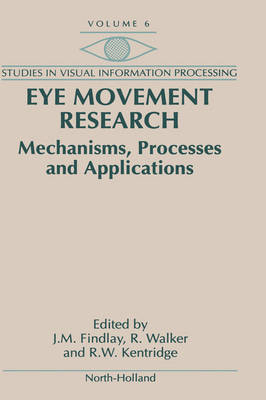
Eye Movement Research
North-Holland (Verlag)
978-0-444-81473-9 (ISBN)
- Titel ist leider vergriffen;
keine Neuauflage - Artikel merken
This volume contains selected and edited papers from the 7th European Conference on Eye Movements (ECEM 7) held in Durham, UK on August 31-September 3 1993. The volume is organized as follows:- Invited Lectures, Pursuit and Co-Ordination, Saccade and Fixation Control, Oculomotor Physiology, Clinical and Medical Aspects of Eye Movements, Eye Movements and Cognition, Eye Movements and Language and finally, Displays and Applications.
Invited Lectures. Eye movement and cognitive processes in reading, visual search, and scene perception (K. Rayner). Models of oculomotor function: An appraisal of the engineer's intrusion into oculomotor physiology (W. Becker). The sensing of optic flow by the primate optokinetic system (F. Miles). The functions of eye movements in animals remote from man (M.F. Land). Pursuit and Co-Ordination. Human eye muscle proprioceptive feedback is involved in target velocity perception during smooth pursuit (J.L. Velay et al.). Variability of sinusoidal tracking characteristics in children (A.P. Accardo et al.). Ocular tracking of self-moved targets: Role of visual and non-visual information in visuo-oculo-manual coordination (J.-L. Vercher et al.). Eye movements evoked by leg-proprioceptive and vestibular stimulation (F.M. Botti et al.). Effects of prediction on smooth pursuit velocity gain in cerebellar patients and controls (G.U. Lekwuwa et al.). Saccade and Fixation Control. The relationship between the initial direction and landing position of saccades (C.J. Erkelens, I.M.L.C. Vogels). Mechanisms for fixation in man: Evidence from saccadic reaction times (M. Biscaldi et al.). Saccade latency towards auditory targets (D. Zambarbieri et al.). Retinal eccentricity and the latency of eye saccades (P.E. Hallett, R.P. Kalesnykas). Is saccadic adaptation context-specific? (H. Deubel). Fast disconjugate adaptations of saccades: Dependency on stimulus characteristics (T. Eggert et al.). Visual mislocalization in moving background and saccadic eye movement conditions (H. Honda). Oculomotor Physiology. A neural mechanism subserving saccade-vergence interactions (L.E. Mays, P.D.R. Gamlin). Eye position effects on pursuit related responses in area LIP of macaque monkey (F. Bremmer, K.-P. Hoffman). Clinical and Medical Aspects of Eye Movements. Problems in modelling congenital nystagmus: Towards a new model (C.M. Harris). Eye movement behaviour in human albinos (R.V. Abadi, E. Pascal). Smooth pursuit responses to step ramp stimuli in patients with discrete frontal lobe lesions (T.J. Crawford et al.). Peak saccade velocities, short latency saccades and their recovery after therapy in a patient with a pineal tumor (L.J. Bour et al.). Eye Movements and Cognition. Evidence relating to premotor theories of visuospatial attention (T.L. Hodgson, H.J. Müller). Visual attention and saccadic eye movements: Evidence for obligatory and selective spatial coupling (W.X. Schneider, H. Deubel). Why some search tasks take longer than others: Using eye movements to redefine reaction times (G.J. Zelinsky, D.L. Sheinberg). Eye movements and response times for the detection of line orientation during visual search (S. Mannan et al.). Chronometry of foveal information extraction during scene perception (P.M.J. van Diepen). Trans-saccadic integration of biological motion: Overview and further evidence based on reaction times (K. Verfaillie et al.). Eye Movements and Language. A challenge to current theories of eye movements in reading (F. Vitu, J.K. O'Regan). Effect of luminance and linguistic information on the centre of gravity of words (C. Beauvillain, K. Doré). PP-attachment in German: results from eye movement studies (L. Konieczny et al.). Individual eye movement patterns in word recognition: Perceptual and linguistic factors (R. Radach et al.). Lexical influences on parsing strategies: Evidence from eye movements (C. Grenck-Mestre, J. Pynte). Effects of a word's morphological complexity on readers' eye fixation patterns (J. Hyönä et al.). Effective visual field size necessary for proof reading during Japanese text editing (N. Osaka et al.). Displays and Applications. Selection by looking: A novel computer interface and its application to psychological research (D.M. Stampe, E.M. Reingold). Eye movement recordings to study determinants of image quality in new display technology (G. Deffner). Eye-gaze determination of user intent at the computer interface (J.H. Goldberg, J.C. Schryver). Knowledge engineering in the domain of visual behaviour of pilots (A. Schulte, R. Onken). Distribution of visual attention revealed by eye movements and neural networks (P. Krappmann). Gaze control in basketball foul shooting (J.N. Vickers).
| Erscheint lt. Verlag | 3.2.1995 |
|---|---|
| Reihe/Serie | Studies in Visual Information Processing |
| Sprache | englisch |
| Gewicht | 1230 g |
| Themenwelt | Geisteswissenschaften ► Psychologie ► Allgemeine Psychologie |
| Geisteswissenschaften ► Psychologie ► Biopsychologie / Neurowissenschaften | |
| Geisteswissenschaften ► Psychologie ► Test in der Psychologie | |
| Geisteswissenschaften ► Psychologie ► Verhaltenstherapie | |
| Medizin / Pharmazie ► Medizinische Fachgebiete ► Neurologie | |
| ISBN-10 | 0-444-81473-6 / 0444814736 |
| ISBN-13 | 978-0-444-81473-9 / 9780444814739 |
| Zustand | Neuware |
| Haben Sie eine Frage zum Produkt? |
aus dem Bereich


